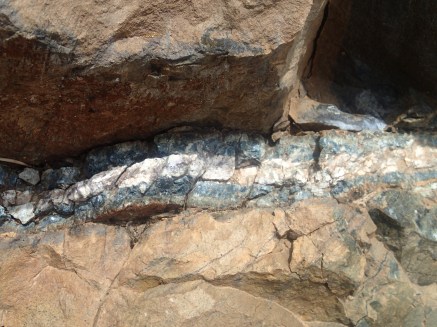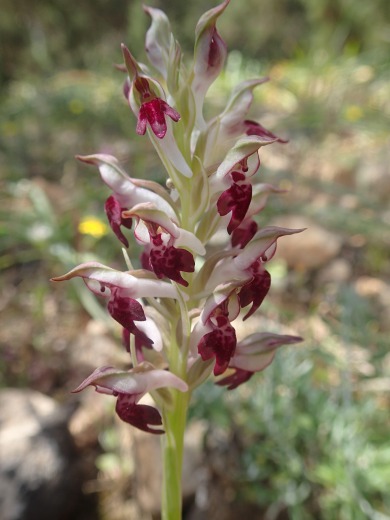During our week in Cyprus in April, predictably, the mountains beckoned. The Tróödhos range occupies much of the centre of the southern part of the island and before we went I thought I should try and find out something about the flora of these mountains, which I knew to be rich and diverse. Cyprus, as a whole, has around 1300 species of flowering plant – as many as the whole of Britain in an area the size of Wales – and around 90 are endemic to the island. This is partly the result of its location; relatively close to Asia Minor, Africa and Mediterranean countries whilst also being geographically isolated from them and too far south to be bothered by recent ice ages.
However, it turns out that the Tróödhos range is even better known for its geology than its ecology. Who knew that these mountains played an important role in geologists’ understanding of sea-floor spreading in the 1960s, which in turn allowed them to propose a mechanism for the continental drift which is a key driver of plate tectonics? Or, that this work was carried out by geologists from the Open University, particularly Professor Ian Gass? The mountains have their origin in lava welling up above a subducting lithospheric slab, some 90 million years ago. The lava erupted onto the sea floor and was eventually lifted up, and the marine sediments which covered it eroded, as a result of the collision between the southern edge of the Anatolian Plate and the African plate, creating the Cyprus island arc. Cyprus itself has a core of igneous rocks surrounded by marine sedimentary ones.
The Tróödhos mountains are a mess of rocks called the Tróödhos Ophiolite; dykes and pillow lavas formed by the extruded lava, marine shales and limestone-like rocks made of radiolarian remains and magnesium and iron-rich (ultra-mafic) rocks from Earth’s mantle. The ophiolite complex includes rich and accessible deposits of asbestos, chromite, copper and iron pyrites and seams of gold and silver. The copper, in particular, was heavily exploited by the ancient Cypriots – Cyprus was one of the first places in the world where copper was systematically processed and used. In fact, the name Cyprus is believed to come from the Latin word cuprum. So unique is the geology of the Tróödhos mountains that the area has been designated a UNESCO Global Geopark.

Gabbro with mineral veins
The variety of underlying rock types and the soils these produce is another key reason for the island’s biodiversity. A good number of Cyprus’s endemic plants are only found in the Tróödhos mountains and the Akamas peninsula. Until about one million years ago, the Tróödhos mountains and the Kyrenia range to the north were on separate islands of the Cyprus arc but slow silting up of the shallow Athalas Sea eventually gave rise to the central plain of the island (the Mesaoria) which, in a curious parallel, forms the border between the Greek south of the island and the Turkish north. Enough geology though – this is supposed to be a botanical post!
One highlight of our trip was a day walking in a long loop around the summit of Mount Olympus; at 1952 m, the highest point on the island. With temperatures in the mid 20s it was hard to picture ski slopes here in winter. The shade cast by Pallas Pine (Pinus nigra subsp. pallasiana) Cyprus cedar (Cedrus brevifola) and Juniperus foetidissima, species limited to the highest parts of the Tróödhos range in Cyprus, made for pleasant walking conditions despite the heat. I’m glad to say the Juniper didn’t live up to its name!

Both the Juniper forest and the serpentinophilous grassland found on more open ground are rare and protected habitats under European law. Three of the species we saw, Corydalis rutifolia, Cynoglossum troodi and Onosma troodi are all mentioned specifically in the habitat description for the Serpentinophilous grassland of Cyprus in the EU Habitats Directive.
Left to right: Corydalis rutifolia, Cynoglossum troodi and Onosma troodi
Very few plants can survive on the metal-rich, serpentine soils which develop on ultramafic rocks such as serpentine, dunite, werhlite and hurzburgite. These species, endemics such as Alyssum troodi, Arabis purpurea and Arenaria rhodia subsp. cypria and near-endemics such as Arenaria saponarioides are able to flourish with little or no competition.
Top: Left, Alyssum troodi; Right, Arabis purpurea
Bottom: Left, Arenaria rhodia subsp. cypria; Right Arenaria saponarioides
One thing that struck me is how closely related these species are to those we find growing on the heavy-metal contaminated land around Nenthead in Cumbria. Alyssum and Arabis are Brassicaceae, like the metallophyte Noccaea caerulescens (Alpine Penny-cress) and Arenaria is a sandwort in the Campion family, like Nenthead’s Minuartia verna.
Left: Noccaea caerulescens and right: Minuartia verna (Nenthead)
Species such as Noccaea, which can accumulate astonishing levels of metals such as zinc and cadmium (up to 5 % of dry weight) are described as hyper-accumulators. They have mechanisms for accumulating and storing potentially-toxic heavy metals safely out of harm’s way in cell vacuoles and cell walls. Is this how the Tróödhos species survive too?
Around 37 of the island’s endemic plant species and subspecies are found only in the Tróödhos Geopark, another reason why this is a great place to see the effect of the underlying geology on plant life. Other Tróödhos endemics we saw included brilliant yellow Ranunculus cadmicus subsp. cyprius on shadier parts of the path….
and the amazingly glandular, hairy leaves of Salvia willeana, yet to produce its yellow flowers.

Other species we found are endemic to Cyprus, but not specifically the Tróödhos range – tiny Ornithogallum chionophilum, for example. The ‘Dynamic checklist’ in the online Flora of Cyprus is a good place to check these things (http://www.flora-of-cyprus.eu/endemics).

Ornithogallum chionophilum
Much of our walk was through dry landscape so, unsurprisingly, many flowering plants are tiny and inconspicuous. Not so the asphodel, Asphodelus ramosus, a robust plant up to a metre tall.
Despite its preference for wet habitats, Viola kitaibeliana, is at the opposite end of the size spectrum, with flowers just a few mm across.

Our circular route included sections of the Atalante and Artemis trails and started and finished at Tróödhos resort – an odd place out of season with no real houses, just a few hotels and lots of shops selling tourist tat. Everyone sprang to life when a coach load of elderly Germans appeared then settled back to their dilatory chatter, just as quickly, when the bus departed. The advertising hoardings piqued our curiosity but it turns out that ‘Commandaria’ is the local dessert wine, drunk in celebration of Aphrodite in ancient Greece!

One slight disappointment for me was a lack of orchids amongst the endemic plants – April is too late in the year for most – but I’d seen plenty of Anacamptis sancta and A. coriophora (previously known as Orchis species) a day or two before on that other Cypriot biodiversity hotspot – the Akamas peninsula.
Anacamptis sancta (left) and A. coriophora (right)
All of this goes to convince me that Cyprus would be an excellent place for the next MacGillivray and Kelly geology/ecology adventure – watch this space!















Very interesting, thank you. I’m here now and am just discovering the joys of the ecology/soils/plants! Have you seen the article by Homer et al. looking at A. t and other hyperaccumulators? https://link.springer.com/article/10.1007/BF00012246)
Thanks a lot – glad you are enjoying Cyprus. The link sounds interesting so I’ll certainly take a look.
[…] April, we visited Cyprus on a family holiday and were sufficiently taken by the place, particularly the Tróödhos […]
[…] I’ve written before about the number of endemic plants on Cyprus and a good number of these are found on and around the Tróödhos mountains, because of the ultra-mafic mantle rocks which form the centre of the range. To have a look at some of these rocks and the plants they support we decided, like last year, to walk part of the Atalante trail on the slopes of Mount Olympus. What a difference a year makes, though. This time last year was hot and dry; the warnings of the risk of forest fires seemed real enough. This year, there were other difficulties… […]
[…] golden saxifrage in the mix too. What makes this site botanically special, however, is the metallophyte flora – specialist plants which can tolerate the high levels of heavy metals in the soils around the […]
[…] he has found several species that had not previously been described, which makes us wonder if the endemism for which the higher plant flora of Cyprus is well-known also extends to the diatoms. There has been a vigorous debate about the extent to which diatoms […]
Can you assist in helping identify certain trees and shrubs that I located in Dhekilia, Cyprus this past week? They are being used to determine which ones produce crescent sun images by virtue of their leaf pattern during a solar eclipse.
I might be able to….
Can you kindly contact me so I can forward some images directly to you via email. My email was embedded in the first reply. I would really appreciate it.
[…] are members of the Asphodel family, like the Asphodelus ramosus and A. fistulosus growing everywhere on Cyprus and the Aloe albiflora flowering in the Botanics […]